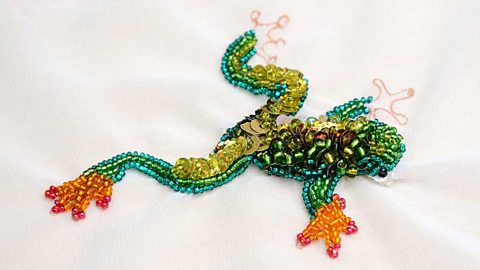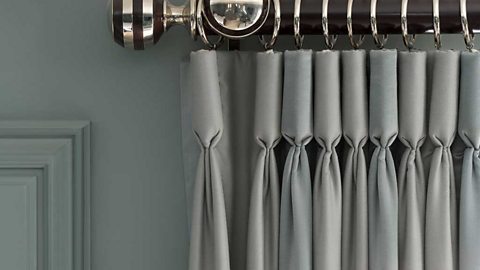Embellishing techniques

Embellishments can be used to decorate garments and textiles. Embellishments include:
- buttons, beads and sequins
- studs
- poppers
- safety pins
- ribbons
- cords and braid
- tassels
- shells
- mirrors
Fabric manipulation
pleatMultiple folds held together by stitching, folds and tuckA tuck in textiles is a fold for decorative purposes can be used to decorate the surface of the fabric.
Smocking is a decorative technique in which fabric is pulled and sewn together using hand stitches to create a pattern.
Suffolk puffs or yo-yos can be used to decorate the fabric. A circle of fabric is hemmed and sewn with running stich around the edge, the thread is pulled, gathering the edge to make a ball, and stitched in place. This can be laid flat or stuffed.
Click through the slideshow to see different ways to manipulate fabric:

Image caption, The top of this curtain makes use of pleats
Image caption, This skirt uses ruffles. These are pleated strips of fabric
Image caption, An example of smocking using a honeycomb chevron stitch
Image caption, Suffolk puffs
1 of 4
Fabric origami
Fabric is used like paper to form 3D origami animals and flowers which can be used as embellishments and decorations. To stiffen fabric, use iron-on interfacing sandwiched between two layers of decorative fabric.
Printing and painting

Printing and painting techniques that can be used to decorate fabric include:
- lino printing
- block printing
- screen printing
- silk painting
- spray painting
- fabric dyeing
- foiling and glitter
Distressing fabric
Designers use a variety of different techniques to age and distressed effectA surface finish that makes something look old or worn. fabric. These techniques include:
- flicking with paint
- bleaching
- fraying with a wire brush or cheese grater
- slashing
- burning with a flame
- melting with a soldering iron or heat gun
- staining
These can be used creatively to add effect or interest to a piece.